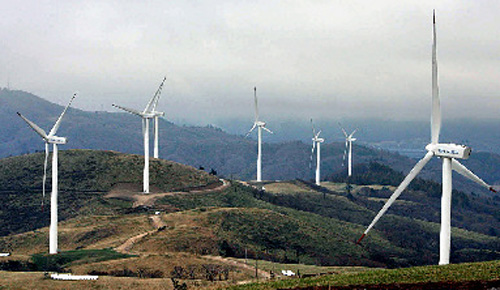Demand for them is huge, while supply is limited.

State-of-the-art windmills generate power using wind velocity in Gangwon Province. The first 12 turbines were put online in December 2005, with 37 added in 2006. Efforts to produce power from alternative sources is a global trend. Solar, geothermal and wind energy are some alternative power sources. [JoongAng Ilbo]
The oil market will face a severe crisis within five years, said a recent report from the International Energy Agency. The price of Brent Blend, used as a benchmark for petroleum price trends, has hit the record price of $79.56 a barrel. Likewise, crop prices are soaring. The Organization for Economic Cooperation and Development (OECD) and the Food and Agricultural Organization have separately warned that here could be a severe shortage of crop supply within 10 years.
Basically, the rapid rise of oil prices is caused by the difference in demand and supply. With the world economy on the upturn, the demand for oil has soared. Added to that, the emerging economies of China, India and other developing countries are gobbling massive amounts of resources. Oil production in some countries, such as Mexico, is slowing, with forecasts that we are beginning to see the bottom of the well. What’s worse is that there hasn’t been much news about new oil fields being discovered. Quite simply, supply could possibly fail to satisfy demand, resulting in rising prices.
The jump in the prices of crops is closely related to the increasing use and interest in biofuels. With the growing consumption of biofuel produced from corn, sugarcane, yams and other crops, the prices of these crops have doubled during the past two to three years. Industry experts predict the production volume of biofuels to increase more than twofold in 10 years.
The rise of crop prices has a direct impact on our daily lives. Popcorn, sold in U.S. movie theaters, became 40 percent more expensive recently because of higher prices for corn, Reuters reported last month. Popcorn prices in Korea also jumped 20 percent during the last 12 months.
Reflecting this phenomenon, a new phrase, “agflation,” has emerged. The word combines agriculture and inflation, in reference to inflation caused by price hikes in agricultural products.
Prices of iron, steel and other minerals are likewise on the rise. The aggressively developing Chinese economy is the biggest reason for this. Moreover, investors have been moving their money to commodities from other sectors. With lower interest rates since 2001, the financial market isn’t as attractive as it used to be. Speculative trade in commodities like oil, crops and minerals is adding fuel to the price hikes caused by the difference between supply and demand.
As raw material prices go up, businesses feel the pinch as costs rise and profits contract. Certain firms lose competitive power and go out of business. Consumers have to either buy products at higher prices or just give up buying. In this case “stagflation” may occur ― when economies are literally stagnating ― and prices continue to rise even during a recession. With scant natural resources, Korea is vulnerable and could lose its advantage in exports. As a result, Korea needs to export more semiconductors than in the past to earn enough hard currency to import each barrel of oil.
The fundamental solution is to develop sustainable energy sources that will not dry up. Like every other country in the world, Korea has been working hard at this. For example, in Jindo, South Jeolla, Korea is beginning to generate power using energy from ocean tides. Energy from the movement of tides is boundless. Solar energy is another alternative energy source that is beginning to be adopted, particularly in countryside homes. The size of solar cell panels has to be large, which makes initial investment relatively large. Once it is installed, additional costs are minimal, eventually lowering the average cost as more solar panels are used. More important, solar energy is perpetual and is also nonpolluting.
While developing alternative energy sources, Korea is also hastening to gain access to overseas energy sources to solve its problem of insufficient energy and resources.
Korean companies are acquiring resource development rights in Malaysia and Mongolia, among other countries.
And no matter what resources are discovered or developed, one thing that must not be overlooked is energy conservation.
Glossary
Commodities are goods for which there is demand. Prices of commodities are determined as a function of their market as a whole ― mainly, supply and demand ― of basic resources and agricultural products such as crude oil, gold, sugar, soybeans and coffee.
Biofuels are fuels consisting of, or derived from, biomass. It is considered a viable alternative to fossil fuels. Biofuel can be produced from carbon sources such as plants, and is therefore renewable. Agricultural products grown for biofuel include soybeans, rapeseed, sugarcane and palm oil.
By Chung Sun-wook JoongAng Ilbo [yhwang@joongang.co.kr]










with the Korea JoongAng Daily
To write comments, please log in to one of the accounts.
Standards Board Policy (0/250자)